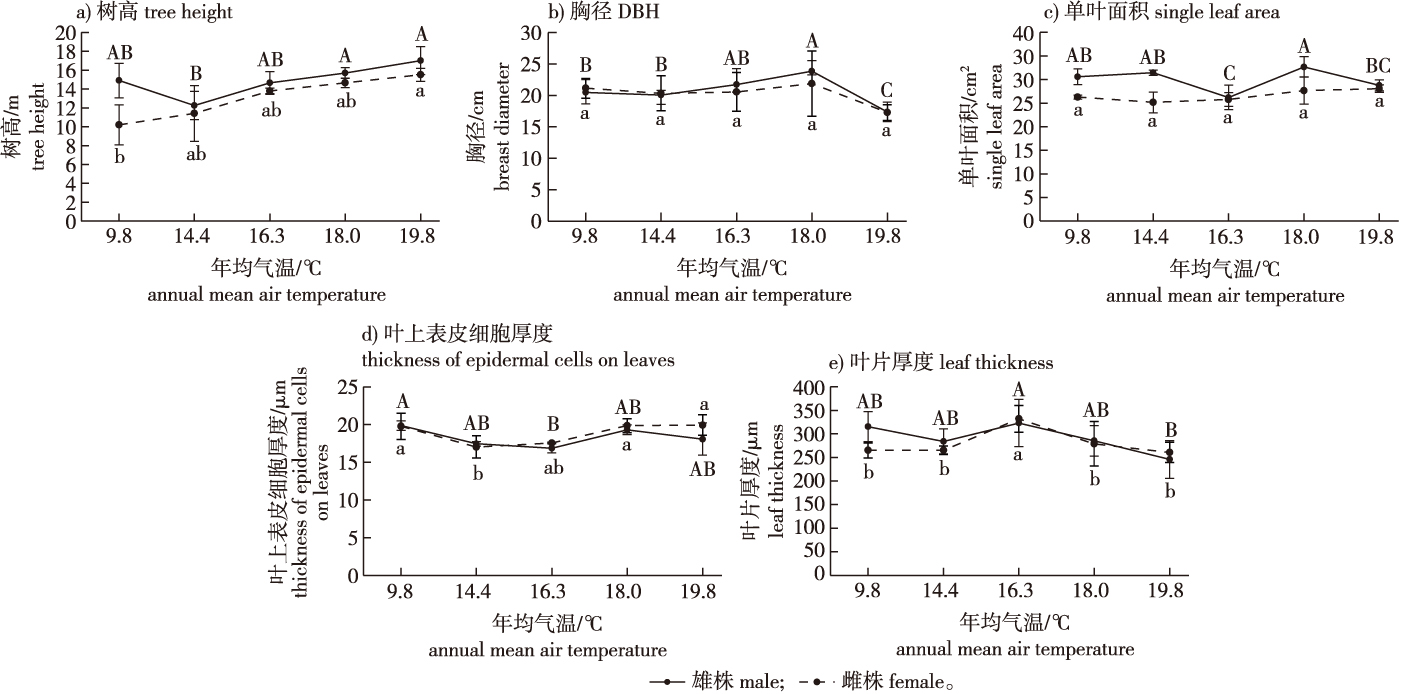 PDF(1958 KB)
PDF(1958 KB)


 PDF(1958 KB)
PDF(1958 KB)
 PDF(1958 KB)
PDF(1958 KB)
雌雄银杏对温度变化的形态和生理响应
Morphological and physiological responses of male and female Ginkgo biloba to temperature changes
【目的】研究成年雌雄银杏(Ginkgo biloba)大树形态和生理指标与其温度适应的相关性,探究银杏对温度变化的响应机制及其性别差异【方法】通过对累年年均降水量为990~1 200 mm,累年年均气温为9.8、14.4、16.3、18.0和19.8 ℃的5个不同地区的同龄成年实生银杏大树生长指标、解剖结构和代谢产物含量进行分析,探究雌雄银杏在野外条件下对温度变化的响应。【结果】在适生条件下,随年均气温的升高,银杏叶面积、树高和胸径逐渐增加,净光合速率随之提高,萜内酯和聚戊烯醇含量逐渐增加,但总黄酮、多酚、多糖和可溶性糖含量却有所降低,表明一定程度的升温有利于银杏的生长和光合作用,提高萜内酯和聚戊烯醇等主要代谢产物的含量,但不利于抗氧化代谢产物的积累。同地区雄株银杏树高、叶面积、总黄酮、多酚、多糖和可溶性糖含量均显著高于雌株。【结论】自然条件下,银杏会根据不同的温度条件来调整自身形态特征、光合作用效率和代谢产物的含量来保证个体的正常生长,累年年均气温16.3~18.0 ℃是最适宜银杏生长的环境温度。银杏对气温的适应存在性别差异,雄株能更好地适应环境变化。
【Objective】This study investigated the response mechanism of ginkgo (Ginkgo biloba) to temperature changes and its gender differences, and clarified the relationship between changes in ginkgo morphology and physiological indexes and their corresponding temperature adaptation.【Method】We explored the response of male and female ginkgo trees to temperature changes under field conditions by measuring the growth index, anatomical structure, and metabolite content of adult ginkgo trees in five areas with an average annual precipitation of 990-1 200 mm and average annual temperatures of 9.8, 14.4, 16.3, 18.0 and 19.8 ℃, respectively.【Result】Under suitable living conditions, the leaf area, tree height, breast diameter, photosynthetic rate (Pn), and terpene lactone and polyvalerenol contents increased with the temperature, while the total flavonoids, polyphenols, polysaccharides, and soluble sugars contents decreased. These indicated that a certain degree of warming was beneficial to the growth and photosynthesis of Ginkgo biloba and increased the content of major metabolites such as terpene lactones and polypentenol, yet it was not promoting the accumulation of antioxidant metabolites. The tree height, leaf area, and total flavonoids, polyphenols, polysaccharides, and soluble sugar contents of male plants were marked higher than those of female plants, while the intercellular CO2 concentration (Ci) was lower than that of female plants.【Conclusion】Under natural conditions, both male and female ginkgo can adjust their morphological characteristics, photosynthetic strategies, and metabolite contents according to different temperature conditions to ensure the normal growth of individuals. The annual average temperature of 16.3-18.0 ℃ is the optimal environmental temperature for G. biloba growth. There exist gender differences in the adaptation of G. biloba to temperature, with the male plant exhibiting a superior ability to adapt to temperature changes.

银杏 / 雌雄株 / 温度 / 叶形态 / 光合特性 / 代谢指标
Ginkgo biloba (ginkgo) / male and female plants / temperature / leaf morphology / photosynthetic characteristics / metabolic index
| [1] |
|
| [2] |
神祥金, 吴正方, 刘彩伶, 等. 长春市木本植物春季物候对气候变化的响应[J]. 中国农学通报, 2012, 28(1):112-117.
|
| [3] |
|
| [4] |
|
| [5] |
陈华圣, 任莉, 许爱华, 等. 不同龄期性别银杏叶多糖含量的比较研究[J]. 中药材, 2006, 29(11):1139-1141.
|
| [6] |
翟飞飞, 毛金梅, 李海栋, 等. 蒿柳1年生雌雄株幼苗的生长与防御差异研究[J]. 西北农林科技大学学报(自然科学版), 2022, 50(8):46-54.
|
| [7] |
郭丽珠, 孟慧珍, 范希峰, 等. 野牛草雌雄株对不同形态氮素的生理响应差异[J]. 草业学报, 2023, 32(2):65-74.
|
| [8] |
黄科朝, 胥晓, 李霄峰, 等. 小五台山青杨雌雄植株树轮生长特性及其对气候变化的响应差异[J]. 植物生态学报, 2014, 38(3):270-280.
|
| [9] |
|
| [10] |
曲红艳. 支气管哮喘采用银杏内酯雾化吸入治疗的效果观察[J]. 中国继续医学教育, 2019, 11(5):138-139.
|
| [11] |
肖斯婷, 曹春然, 刘红艳, 等. 银杏叶提取物的药学研究进展[J]. 中国药事, 2022, 36(4):429-443.
|
| [12] |
|
| [13] |
|
| [14] |
|
| [15] |
|
| [16] |
徐友, 曹福亮, 汪贵斌, 等. 温度和光强对银杏生长的影响[J]. 林业科技开发, 2015, 29(4):41-45.
|
| [17] |
徐友, 王欢利, 汪贵斌, 等. 温度和光照强度对银杏叶黄酮合成的影响[J]. 中南林业科技大学学报, 2016, 36(4):30-34.
|
| [18] |
国颖. 气候变化背景下银杏分布预测及表型性状的环境响应机制研究[D]. 南京: 南京林业大学, 2021.
|
| [19] |
|
| [20] |
|
| [21] |
|
| [22] |
许继业, 郁万文, 曹福亮, 等. 不同雄株银杏叶提取液抗氧化能力及主要功能成分含量差异[J]. 食品与发酵工业, 2022, 48(5):142-149.
|
| [23] |
郁万文, 罗天宇, 曹福亮, 等. 不同品种和树龄银杏叶聚戊烯醇含量的年动态特征[J]. 经济林研究, 2019, 37(2):1-6.
|
| [24] |
冯进, 李敏, 曾晓雄, 等. 大孔树脂纯化蓝莓叶多酚及其组成分析[J]. 食品科学, 2013, 34(10):86-91.
|
| [25] |
|
| [26] |
|
| [27] |
徐友. 温度和光强对银杏生长和次生代谢产物合成的影响[D]. 南京: 南京林业大学, 2016.
|
| [28] |
黄鑫浩. 苦楝光合作用对Zn胁迫的响应和适应机制研究[D]. 长沙: 中南林业科技大学, 2021.
|
| [29] |
钱文武, 郭鹏, 朱慧森, 等. 草地早熟禾叶片表皮特征、解剖结构及光合特性对不同施氮量的响应[J]. 草业学报, 2023, 32(1):131-143.
|
| [30] |
|
| [31] |
|
| [32] |
赵宏瑾, 朱仲元, 王喜喜, 等. 不同生育期榆树净光合速率对生态因子和生理因子的响应[J]. 生态学报, 2016, 36(6):1645-1651.
|
| [33] |
黄曦叶, 何林江, 刘金平, 等. 葎草水分和光合特征及抗性物质含量响应冬季降温的性别差异[J]. 草业学报, 2020, 29(2):103-113.
|
| [34] |
杨扬, 周斌, 赵文杰. 银杏叶史话:中药/植物药研究开发的典范[J]. 中草药, 2016, 47(15):2579-2591.
|
| [35] |
王鼎豪. NAA和多效唑对银杏叶黄酮和萜内酯合成与积累的影响[D]. 南京: 南京林业大学, 2021.
|
| [36] |
|
| [37] |
罗天宇. 银杏叶聚戊烯醇的含量分析及其提取分离研究[D]. 南京: 南京林业大学, 2017.
|
| [38] |
|
| [39] |
郁丹红, 姜玮, 姚鑫, 等. 基于UPLC-TQ-MS考察不同树龄银杏叶双黄酮含量变化规律[J]. 中国实验方剂学杂志, 2019, 25(18):145-149.
|
| [40] |
闫旭宇, 李娟, 任潘, 等. 银杏叶多酚超声辅助提取工艺及其对羟自由基的清除作用[J]. 食品研究与开发, 2020, 41(19):99-104.
|
| [41] |
|
| [42] |
何彩文. 温度对采后灵芝多糖和灵芝酸代谢的影响[D]. 福州: 福建师范大学, 2020.
|
| [43] |
岳世彦, 周荣荣, 南铁贵, 等. 粉葛与葛根中主要化学成分的含量比较[J]. 中国中药杂志, 2022, 47(10):2689-2697.
|
| [44] |
郭海燕, 段婧, 刘金平, 等. 温度对雌雄葎草生理代谢及保护酶系统影响的性别差异[J]. 草业学报, 2017, 26(10):198-206.
|
| [45] |
吴雅琼, 国靖, 周琦, 等. 不同产地银杏黄酮及相关活性物质含量变异分析[J]. 南京林业大学学报(自然科学版), 2019, 43(3):183-188.
|
/
| 〈 |
|
〉 |